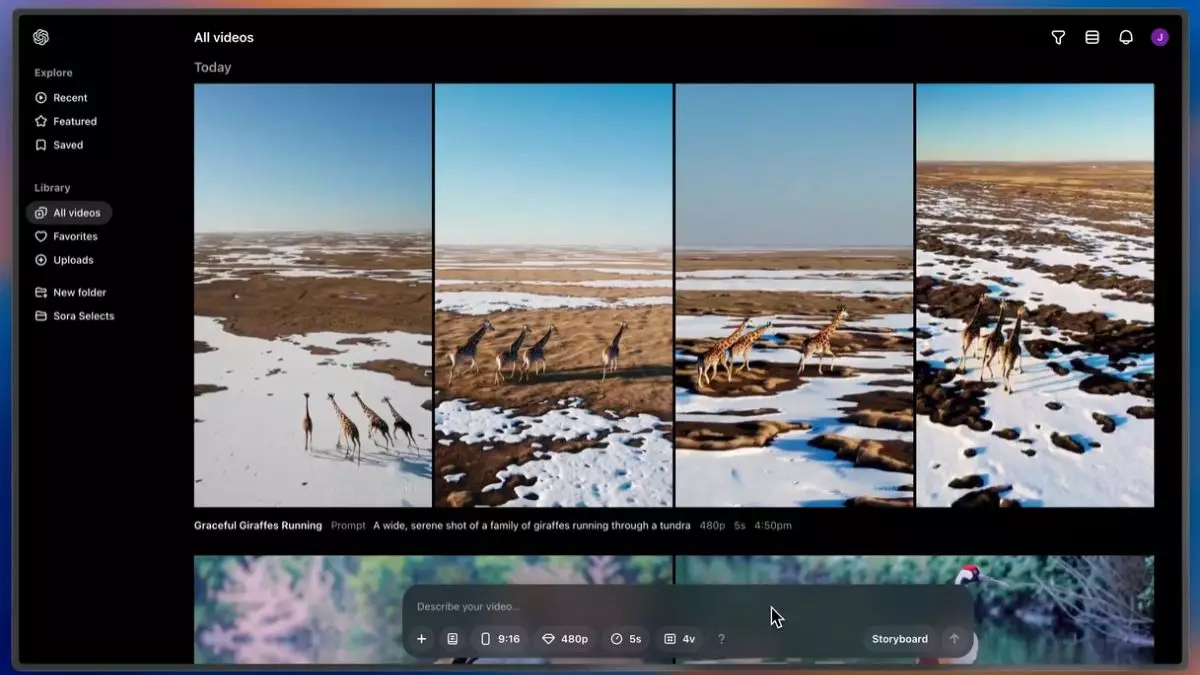Artificial intelligence stands at the forefront of technological innovation, transforming how we create and consume content. OpenAI has made strides in this domain with the unveiling of its new video generation model, Sora. Announced recently, Sora aims to redefine video creation by allowing users to generate high-quality videos using AI—marking a significant milestone in the company’s trajectory.
Sora is designed to generate videos in impressive 1080p resolution, providing users with the ability to create engaging content up to 20 seconds long. The model is accessible through a dedicated platform available as a website but comes with a notable caveat: it is currently exclusive to paid subscribers of ChatGPT. Such a move indicates OpenAI’s intention to monetize this groundbreaking tool while ensuring that only those willing to invest can access its capabilities.
To cater to different user needs, OpenAI has launched a variant called Sora Turbo. This variant aims to enhance the user experience, enabling a wider variety of video generation outputs. However, this tiered approach also raises questions about accessibility for casual users, as only ChatGPT Plus and Pro subscribers can sign up on the website, effectively leaving many potential users out of the loop.
Sora allows users to generate videos dynamically through text prompts. This user-friendliness is accompanied by a storyboard interface that enables the customization of individual frames. Users can experiment with different video formats, including widescreen, vertical, and square aspect ratios, enhancing the versatility of content production. Furthermore, the platform allows users to upload their own media, thus facilitating a blend of original and AI-generated content.
However, while Sora’s features are robust, the limitations imposed on free users and the capped generation rates for paid subscribers may dilute the initial enthusiasm for such an advanced tool. Plus users are restricted to generating a limited number of videos at varying resolutions, while those on the Pro plan, at a hefty $200 monthly fee, gain access to significantly elevated video generation capabilities. Yet, specifics pertaining to what constitutes “higher resolutions” and “longer durations” remain vaguely defined, potentially leading to confusion and dissatisfaction among users seeking clarity.
Delving into the technical side, Sora harnesses a diffusion model and transformer architecture that allows for consistency across frames. In simpler terms, this means that the AI can visualize multiple frames simultaneously, creating a seamless viewing experience over the 20-second video duration. By incorporating recaptioning techniques similar to its predecessor DALL-E 3, Sora builds upon proven methodologies in AI design while also continuing to innovate.
The data sourcing strategy employed by OpenAI also deserves attention. The model was trained on a diverse dataset comprised of publicly available information, data from collaborations with other companies, and contributions from users working with the AI. Such exhaustive data collection efforts aim to optimize the output quality, yet they also bring forth questions regarding data ethics and privacy. OpenAI’s commitment to sourcing data responsibly is commendable, but transparency in its data collection methods will be crucial in gaining long-term user trust.
OpenAI has taken significant steps to mitigate the risks associated with generating realistic AI videos. By implementing visible watermarks and metadata in accordance with the Coalition for Content Provenance and Authenticity (C2PA), the company demonstrates awareness of the potential misuse of video generation technology. They’ve made it clear that Sora will be programmed to block the production of harmful content, including child sexual abuse materials and misleading deepfakes. In doing so, OpenAI is attempting to navigate the fine line between innovation and ethical responsibility.
However, while these protective measures are crucial, the effectiveness of such safeguards will ultimately depend on their implementation and user compliance. The question remains whether these efforts will be sufficient to prevent misuse, given the complexities involved in regulating creative AI technologies.
The launch of Sora marks a pivotal moment in AI-driven video generation, with its vast capabilities poised to revolutionize content creation. Nevertheless, the limitations imposed on access, coupled with ethical concerns surrounding data usage and content safety, create a multifaceted scenario that OpenAI must navigate deftly. As the conversations around AI and its societal impacts continue to evolve, Sora’s reception and handling of potential challenges will be key determinants of its success in the competitive landscape of AI technology.

